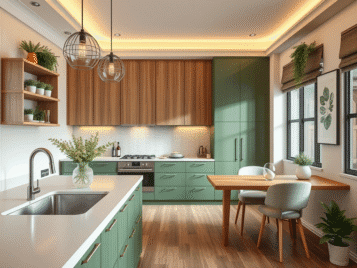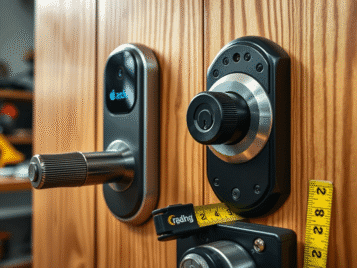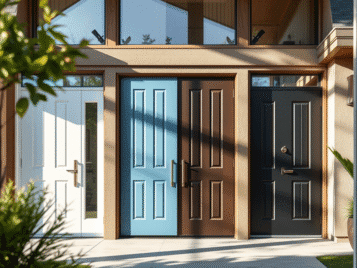Mixed‑material façades—sleek aluminium fields framed by warm‑toned compact laminates—are transforming buildings from Oslo to Ahmedabad. The look is striking, yet a single mismatched shade can ruin the entire composition. Paint systems, overlay films, and resin cores all reflect light differently, so the art lies in controlling hue, gloss, and ageing behaviour across both ACP and SamratHPL HPL surfaces. This guide shows you how.
1. Why Colours Drift Between Materials
| Factor | ACP Paint System | Compact HPL Overlay |
|---|---|---|
| Pigment carrier | Polyester / PVDF | Acrylic‑PU dual cure |
| Gloss range | 15 – 70 GU | 5 – 30 GU (matt to ultra‑matt) |
| UV fade resistance | ΔE < 5 after 2 000–3 000 h QUV | ΔE < 2 after 3 500 h QUV |
| Texture | Smooth / brushed | Wood, stone, textile, solid |
Different binders and gloss levels change the way our eyes perceive the same pigment. That’s why a perfect RAL code on ACP can appear a shade off when placed beside an HPL panel.
2. Start With the Right Colour Reference
- Define a master tone—usually a RAL or NCS code.
- Request production samples for both ACP and SamratHPL HPL in that tone.
- Label each batch with date, shift, and lacquer lot. Consistency begins with documentation.
3. Use Delta E to Quantify “Close Enough”
A spectrophotometer measures the colour difference (ΔE). For façades viewed outdoors:
- ΔE ≤ 1.0—Indistinguishable to the human eye.
- ΔE 1.0 – 1.5—Acceptable on large surfaces.
- ΔE > 1.5—Noticeable; risk of patchy walls.
Aim for ΔE ≤ 1.5 between the ACP coil and SamratHPL overlay sheet under D65 daylight.
4. Control Gloss to Avoid “Two‑Tone” Reflections
Even identical hues can look different if one surface is glossier. Solutions:
- Specify low‑gloss ACP clear coats (20 ± 5 GU) to approach the ultra‑matt finish of SamratHPL’s exterior laminates.
- If glossier aluminium is unavoidable, introduce a deliberate sheen contrast rather than an accidental mismatch—e.g., glossy metal field set inside a matt‑black HPL frame.
5. Account for UV Ageing From Day One
- In hot, high‑UV regions like southern Spain or coastal Gujarat, select PVDF‑top‑coated ACP and SamratHPL UV+ laminates to minimise fade.
- For colder, low‑UV climates, standard polyester ACP with SamratHPL exterior grade still meets 15‑year colour warranties.
Always orient sample boards south‑facing for site mock‑ups; early fade becomes obvious in six months.
6. Texture Alignment: Grain & Brush Direction
ACP comes in brushed metal or woodgrain films; SamratHPL offers wood, stone, and textile textures. Keep grain direction consistent across both materials:
- Vertical timber grain flanks + vertical brushed aluminium ribs = harmonious.
- Mixing vertical HPL grain with horizontal ACP brush lines = visual clash.
7. Build a Site Sample Board—Step by Step
- Screw a 600 × 600 mm ACP cassette and an equal‑size SamratHPL panel onto a plywood backer.
- Mask a 10 mm joint gap to simulate open‑joint appearance.
- Review in morning, noon, and late‑afternoon light.
- Photograph with a colour‑calibrated card for record keeping.
Only approve mass production once the board passes ΔE and on‑site visual tests.
8. Installation Details That Preserve Colour Harmony
Batch Segregation
- Use panels from the same production lot on each elevation.
- Mark crate numbers and elevation zones; mix‑ups happen fastest on crowded sites.
Orientation Checks
- Maintain consistent “arrow up” orientation on both ACP and HPL; coatings can appear lighter if inverted.
Cleaning Protocol
- Wipe fingerprints immediately—skin oils darken ultra‑matt HPL patches.
- Use pH‑neutral soap on both surfaces; avoid abrasive pads that raise gloss spots.
9. Cost of Special‑Match Finishes (mid‑2025)
| Region | Custom‑colour ACP (FR core) | Custom SamratHPL (≤ 200 m² order) |
|---|---|---|
| India (₹/sq ft) | +₹35 – ₹50 over standard colour | +₹25 – ₹40 over stock finish |
| Germany (€/m²) | +€12 – €18 | +€8 – €12 |
| Spain (€/m²) | +€10 – €16 | +€7 – €11 |
Colour mastery adds a modest premium but prevents costly re‑clads and reputational risk.
10. Quick‑Reference Checklist
- Master colour code chosen (RAL/NCS).
- Production samples approved under D65 daylight.
- ΔE ≤ 1.5 confirmed with spectrophotometer.
- Gloss matched or deliberately contrasted.
- Texture direction aligned on drawings.
- Site sample board reviewed at three times of day.
- Batch labels mapped to elevations.
- Cleaning plan issued to contractor.
Final Word
Colour consistency is equal parts science and choreography: specs, instruments, mock‑ups, and vigilant site control. Follow these steps and your mixed‑material façade—sleek aluminium beside rich SamratHPL laminates—will age gracefully, without the patchwork effect that haunts so many projects. The reward: a building that looks intentional, cohesive, and timeless whether you first see it at sunrise in Copenhagen or dusk in Chennai.



